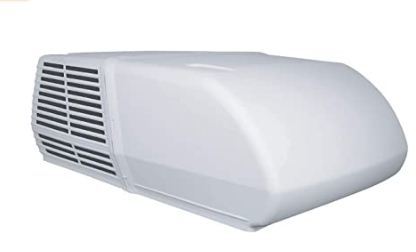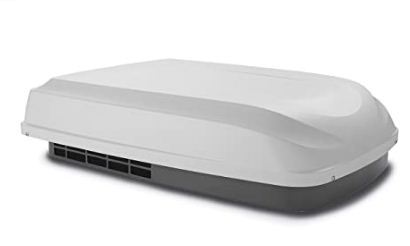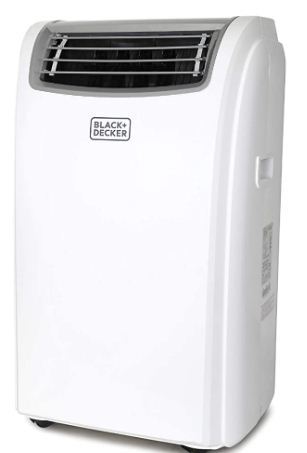Shopping for a new air conditioner for your RV?
You’ve come to the right place.
The cool air coming from your RV’s dashboard is not enough to cool the entire vehicle. To keep the entire RV comfortable, you’ll need a proper air conditioning system.
A rooftop AC is the most popular option. You can also use a portable air conditioner, a window AC or an under-bench AC.
What’s In this Buying Guide?
In this buying guide, we review the best RV air conditioners for 2022. We also explain the different types of RV ACs and give you tips on how to choose the right air conditioner for your RV.
6 Best RV Air Conditioners
Disclaimer: All links below go to Amazon.com
- 1Editor's Choice: Dometic Brisk Air 2 Rooftop Air Conditioner
- 2Best Ducted System: Coleman Airxcel 08-0080 Mach 15
- 3Best for Small and Medium Size RVs: Coleman Airxcel 08-0079 Mach 3 Plus
- 4Best Low Profile: Dometic 640315C Penguin II
- 5Best Budget: ASA Electronics ACM135B
- 6Best Portable: Black + Decker BPACT12HWT Portable Air Conditioner
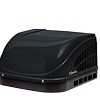
Dometic Brisk II
- Editor’s Choice
- 15,000 BTUs
- 350 CFM airflow
Heating capacity:
5,600 BTUsType:
Ducted/non-ductedWeight:
74lbsWarranty:
2 years

Coleman Mach 15
- Best ducted system
- 15,000 BTUs
- 320 CFM airflow
Heating capacity:
5,600 BTUsType:
DuctedWeight:
90lbsWarranty:
2 years

Coleman Mach 3
- Best for small and medium size RVs
- 13,500 BTUs
- 320 CFM airflow
Heating capacity:
5,600 BTUsType:
Non-ductedWeight:
79.5lbsWarranty:
2 years

Dometic Penguin II
- Best low profile
- 15,000 BTUs
- 350 CFM airflow
Heating capacity:
5,600 BTUsType:
Ducted/non-ductedWeight:
99lbsWarranty:
2 years
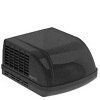
ASA Electronics Advent
- Best budget
- 13,500 BTUs
- Airflow Not specified
Heating capacity:
5,600 BTUsType:
Ducted/non-ductedWeight:
68.4lbsWarranty:
not specified
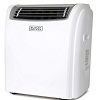
Black + Decker BPACT12HWT
- Best portable
- 12,000 BTUs
- Airflow Not specified
Heating capacity:
9,000 BTUsType:
PortableWeight:
68lbsWarranty:
1yr parts, 5yrs compressor
Best RV Air Conditioners : In-Depth Reviews
1. Editor's Choice: Dometic Brisk Air II Rooftop Air Conditioner
The Dometic Brisk II Rooftop Air Conditioner is the best AC for most RVs. At 15,000 BTUs, it has no trouble cooling down even large RVs.
You can install the Brisk II as a ducted or non-ducted system. It also comes with a heating option.
Pros
- Can be ducted or non-ducted.
- High cooling capacity.
- Heating option (requires a heat strip).
- Lightweight and durable design.
- Easy to install.
Cons
- A bit noisy.
- Control unit and heat strip not included.
Our Review
The Dometic Brisk II is designed to cool a large RV quickly and efficiently. In addition to the high 15,000 BTU capacity, it also boasts a high 350 CFM airflow. (review)
The high airflow pushes lots of cool air into the RV interior, keeping it comfortable even in extra-hot weather.
The design of the Dometic Brisk II allows for both ducted and non-ducted installation. If you are replacing a ducted AC, you can just connect the Brisk II to the existing duct system.
If you don’t have any ducting, the Brisk II works just as well, though you’ll need to purchase a control panel separately.
In addition to cooling, the Brisk II AC can also warm your RV. You’ll need to buy a heating strip to use the heating feature. Also, note that heating capacity is much lower (5,600 BTUs) compared to cooling capacity.
Installation is easy. The hardest bit is lifting the unit up to the roof. Dometic have made the Brisk II as light as they could while maintaining its durability. This is not just to make it easier to install; it also minimizes the effect on your vehicle’s fuel efficiency.
The Dometic Brisk II features a galvanized steel top plate and a carbon steel base to ensure it can withstand vibrations and all kinds of road conditions.
The unit comes with a 2-year warranty.
Issues and Limitations
The Dometic Brisk II has no issues with noisy vibrations. It utilizes a special design to reduce noise from the motor, compressor and evaporator. However, it’s still fairly noisy. The issue is the fan.
Likely because of the high airflow, the fanproduces a fair amount of noise.
Another issue with the Dometic Brisk II is that it doesn’t come with a control panel and a heating strip. If you are installing it as a ductless system, you’ll have to buy the control panel. If you want to warm your RV, you have to buy a heat strip.
2. Best Ducted System: Coleman Airxcel 08-0080 Mach 15
If you already have a duct system in you RV, or you are planning to install one, The Coleman Airxcel Mach 15 is the best air conditioner.
It has the same cooling capacity as the Dometic Brisk II, making it ideal for larger RVs.
Pros
- High cooling capacity.
- Optional heating feature.
- High airflow.
- Quiet operation.
- Easy to install.
- 2-year warranty.
Cons
- Poor packaging.
- Heat strip and control panel not included.
Our Review
The Coleman Mach 15 is designed specifically for ducted systems. If you are replacing a ducted AC, replace it with this one. (Review)
The Mach 15 is also a great option if you want to upgrade to a higher-BTU air conditioner. At 15,000 BTUs, it cools down the RV quickly and keeps temperatures down no matter how hot it gets outside.
The airflow – 320 CFM – is slightly lower than that of the Brisk II, but it’s still powerful enough to drive plenty of cool air into the RV. It also balances perfectly between power and quiet.
We’ve not seen too many complaints regarding fan noise, which is an issue with the Brisk II.
For chilly day, the Mach 15 has an optional 5,600 BTU heating feature, though you’ll need to buy a heat strip.
Installation is easy, with the hardest part being getting the heavy unit to the roof and taking the old one down.
In most cases, the Mach 15 AC works smoothly with the existing control panel and thermostat, even if they are from other brands. You don’t have to buy everything anew.
As for design and build, the Coleman Mach 15 is slightly heavier than the Brisk II. But it still shouldn’t affect your driving experience or fuel efficiency.
A streamlined shape improves aerodynamics while a solid construction reduces vibrations and increases longevity.
Issues and Limitations
The main complaint from customers is about the Mach 15’s poor packaging. A significant number of customers received their unit with a dent on the metal chassis. Thankfully, it doesn’t seem to affect the AC’s operation.
Another issue is that the AC doesn’t come with a control panel, thermostat or heat strip. If you are replacing an old system, you probably already have the controller and thermostat. But if you want to enjoy some warmth, you have to buy the heating element.
3. Best for Small and Medium Size RVs: Coleman Airxcel 08-0079 Mach 3 Plus
For small to medium size RVs such as a campervan, a 13,500 BTU air conditioner provides plenty of cooling power. It’s also a cheaper option compared to a 15,000 BTU AC.
We recommend the Coleman Mach 3 Plus, the smaller sibling to the Coleman Mach 15.
Pros
- Great for smaller RVs.
- High airflow.
- Optional heating feature.
- Easy to install.
Cons
- Not ideal for large RVs and hot climates.
Our Review
The Coleman Mach 3 Plus is designed for non-ducted systems, so installation is easy. Once you get it up on the roof, the rest is a piece of cake.
Similar to other ACs, the Mach 3 Plus doesn’t come with a control panel. You can use your old one or order a new one separately.
Cooling performance is pretty good, as long as you use it in a small to medium size RV. The 13,500 BTU output drops temperature quickly. The high 320 CFM airflow also helps cool your RV quickly.
The Mach 3 Plus also comes with a heating option, though you’ll have to buy a heat strip separately. As usual, the heat output is much lower (5,600 BTUs) compared to the cooling capacity.
The Mach 3 Plus has a durable construction that stands up well to years of use and exposure to elements. It is significantly lighter than the Mach 15 and has a streamlined design, both of which are great for your vehicle’s fuel efficiency.
Issues and Limitations
If you own a big Class A RV or a large trailer, we do not recommend the Coleman Mach 3 Plus. Get a 15,000-BTU AC instead. Trust us, the 1,500 extra BTUs make a big difference in terms of comfort.
If you have a smaller RV, but live in a hot climate or frequently travel to hot places, we also recommend a 15,000-BTU model. It’ll do a better job keeping you cool in really hot weather.
4. Best Low Profile: Dometic 640315C Penguin II
If you don’t like the look of a big boxy AC sitting on the roof of your RV, the Dometic 640315C Penguin II AC has a beautiful low profile design.
Barely 10 inches high, the low profile design not only looks good, but also improves aerodynamics when you are driving.
Pros
- Sleek modern design that looks great and reduces drag.
- Compatible with ducted and non-ducted systems.
- Easy to install.
- Optional heating feature.
Cons
- Not ideal for large RVs.
- A bit noisy.
- Extra accessories needed.
Our Review
The sleek look of the Dometic Penguin II is not just for show; it also has a practical purpose. It improves aerodynamics and ensures your RV’s fuel consumption doesn’t rise too high.
The low profile design is also great for RVs that want to stay below a certain height because of regulations or to avoid hitting the garage door.
You can get the Dometic Penguin II in two colors: polar white or black.
The Dometic Penguin IIis designed to work with either ducted or non-ducted RV cooling systems. It has an output of 13,500 BTUs, making it ideal for small and medium size RVs. The 320 CFM airflow is powerful enough to cool the RV quickly, even in hot weather.
Similar to other DometicACs, the Penguin II uses EPP foam housing to reduce the weight of the AC and improve airflow.
The Penguin II is still quite heavy; you’ll need one or two other people to get it up on the roof. But once it’s up, installation is easy.
The optional heating feature has an output of 5,600 BTUs. Though not enough to heat the RV comfortably, it’s great for mildly cool weather.
Issues and Limitations
The Dometic Penguin II’s 13,500 BTU output limits it to small and medium size RVs. For larger RVs or if you spend a lot of time in hot climates, we recommend a bigger 15,000-BTU AC.
Dometic has a bigger version of the Penguin II. They call it the Penguin II High Capacity AC. It has the low profile design as the 13,500 BTU model. The manufacturer doesn’t give the exact BTU rating; they just say it’s close to 15,000. (
One issue many customers have mentioned is the amount of noise the Penguin II makes. It’s not a ‘wake you up in the middle of the night’ kind of noise, but the fan is loud enough that it makes it harder to fall asleep or watch a movie.
You can turn down the blower speed to reduce noise, though this will cool the RV slower.
Something else to note is that you’ll need to buy some accessories before you can install and use the Penguin II. These include a ceiling kit for non-ducted systems and a heat strip if you’d like to warm your RV using the Penguin II AC.
For ducted systems, you only need a thermostat. If you already have one, it’ll likely work perfectly with the Penguin II AC.
5. Best Budget: ASA Electronics ACM135BAdvent
If you are shopping on a budget, the ASA Electronics Advent is one of the most affordable RV air conditioners.
It has a cooling capacity of 13,500 BTUs, and has an optional heat strip available separately.
Pros
- Good value for money.
- Enough cooling power for most RVs, camper vans and trailers.
- Optional heat strip.
- Rigid metal construction.
- Variable fan speed.
Cons
- Not ideal for large RVs.
- Doesn’t include all accessories.
Our Review
The ASA Electronics Advent is one of the cheaper rooftop RV air conditioners in the market. That’s not to mean it’s terrible or poorly made.
It cools just as quickly and efficiently as other similar capacity BTUs, and even comes with an optional heating feature.
The Advent AC features a rigid metal base to ensure it can withstand all kinds of road conditions, from smooth to bumpy. The design is not as slick or aerodynamic as some pricier brands, but you shouldn’t see a big effect on fuel consumption.
Installation is super easy and it works both as a ducted or non-ducted system. The AC comes with a watertight gasket to seal the rooftop vent and six foam support pads.
Issues and Limitations
Before you rejoice at the low price, note that the ASA Electronics Advent doesn’t come with all the accessories you need.
If, like most RV owners, you plan to use it as a non-ducted system, you’ll need to buy a ceiling control kit. And if you want to warm your RV, you’ll need to buy a heat strip.
Another issue with the ASA Electronics Advent is it cooling capacity. It’s perfect for small and medium size RVs, but if you’ve got a big Class A RV, either get two of these or just buy a 15,000 BTU unit.
6.Best Portable: Black + Decker BPACT12HWT Portable Air Conditioner
A portable air conditioner is a great choice if you don’t want to deal with the installation work involved with a conventional rooftop AC.
A portable AC is also great if you want to move around with the unit. You can set it up at different areas of the RV or even use it in your home when you are not on the road.
One of the best portable ACs for RVs is the Black + Decker BPACT12HWT. It has a high cooling capacity, it’s also great for heating and the price isn’t too bad.
Pros
- Portable.
- Cheaper than a rooftop AC.
- Heats and cools without requiring any extra accessories.
- Easy to set up.
- Thermostat temperature control.
Cons
- Doesn’t cool as fast as a rooftop model.
- Noisy when the fan is set on high.
Our Review
One reason to get a portable AC over a rooftop model is the price difference. The Black + Decker BPACT12HWT has only 3,000 BTUs less than top rooftop ACs, but costs less than half.
The 12,000-BTU Black + Deckeris perfect for small RVs including camper vans and small trailers. You can also use it in a big RV, but as a zone AC to cool down a specific area.
Another option is to use the Black + Decker portable AC as a backup or supplement air conditioner to your main rooftop AC.
Where the Black + Decker AC outdoes rooftop ACs is in heating. It has a higher heating capacity (9,000 BTU) than the 5,600 BTU most rooftop ACs offer. In addition, it is ready to heat out of the box. This is unlike rooftop models that require a heat strip.
The Black + Decker portable AC comes with a remote control with which you can set your preferred temperature, adjust fan speed and choose between various modes including sleep mode.
The remote control also includes a dehumidification setting that’s handy when the air feels muggy. In most cases, the AC will auto-evaporate moisture it collects from the air. There’s no need to drain it manually.
As for installation, the Black + Decker BPACT12HWT comes as a complete kit with everything you need to set it up. All you need to do is setup the exhaust kit through a window.
If you cannot vent the AC through a window, you can vent it through the wall though that will take more work and time to set up.
Issues and Limitations
If you have a large RV, don’t expect the Black + Decker portable AC to cool the entire space. The AC is designed to cool and heat small spaces.
That’s why we recommend using it in a small RV or as a zone or backup AC in a large RV.
One issue you’ll have to contend with is fan noise, which can be especially loud in a small RV. To reduce the noise level, either lower fan speed or switch to sleep mode.
Buying Guide: What to Look for When Buying an RV Air Conditioner
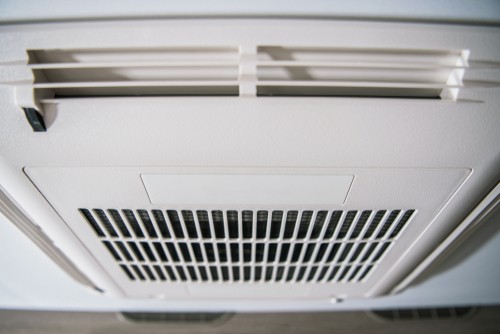
Type
Here are the different types of RV air conditioners.
Rooftop: The best option for most RVs. Rooftop ACs are powerful, relatively quiet and don’t take up usable space. They are available in ducted and non-ducted options. The main downside of rooftop RV ACs is that they are expensive and very heavy.
Portable: Most RV owners use a portable AC as a backup for a rooftop AC or to supplement it.
You can also use a portable AC on its own in a small RV. Portable ACs can be moved around and are much cheaper than rooftop models. On the downside, they don’t offer as much cooling power and you need to find a way to vent the AC out of a window or through the wall.
Window: A window AC is another great alternative to a conventional rooftop unit. Like portable ACs, window ACs are cheaper and easier to install than rooftop ACs. On the downside, not all RVs have the right type of windows that can hold a window AC. Also, most window ACs can only cool small spaces.
Under-bench: If you don’t have the roof space to install a rooftop AC or don’t want to make you RV any higher than it is, an under-bench unit is a good alternative.Most under-bench ACs work with a ducted system to deliver cool or warm air throughout the RV.
Cooling Capacity
Once you decide which type of AC suits your RV, the next thing to decide is how much cooling capacity you need. This comes down to how big your RVs and the kind of places you often travel to.
For rooftop ACs, you have to choices: 15,000 BTUs and 13,500 BTUs. For most RVs, we recommend a 15,000 BTU mode. It’s better to have a bit more cooling power than you need than underestimating how much cooling capacity you need.
A 13,500 BTU unit is ideal for smaller RVs or if you spend most of your time in mild climates where it doesn’t get too hot.
For other types of ACs, calculate 20 BTUs per square foot of your RV living space. For a 270 sq. ft. RV, this comes with 5,400 BTUs. However, if you spend time in hot climates, add more BTUs to get faster cooling.
Also, remember that RVs generally have poor insulation compared to a house. Even for mild climates, it’s a good idea to add more BTUs on top to ensure proper comfort.
Ducted or Non-Ducted
If you decide to get a rooftop AC, your options are ducted or non-ducted. The best choice depends on what system you have in your RV.
If your RV has ducting, get a ducted AC. If it doesn’t, get a non-ducted AC. None has any particularly major advantage over the other.
Note: Most rooftop ACs can work as ducted or non-ducted systems.
Heater
Check if the AC has a heating option. It’ll be handy on chilly days. If it does have this option, check the heating capacity.
For rooftop AC’s, it’s usually 5,600 BTUs. You’ll also need to buy a heat strip to use the heating feature.
In most cases, an air conditioner with a heater will not be enough to keep the RV warm. The heater is ideal only for mildly chilly weather or for zone heating.
Most RV owners have a dedicated RV furnace for heating.
Other Factors to Consider
Installation: Can you install the AC yourself? Also, check if the AC comes with everything you need. For roof ACs, you have to buy the ceiling kit and heat strip separately.
Clearance: How high is the rooftop AC? If you are worried about exceeding height requirements or hitting the top of the garage, get a low profile rooftop AC. A portable, window or under-bench AC also eliminates clearance issues.
Noise level: If you find it hard to sleep if it’s not totally quiet, look for an air conditioner that operates quietly. Note, however, that most ACs will be relatively noisy in the small space of an RV.
Verdict: Which is the Best RV Air Conditioner?
The Dometic Brisk II Rooftop Air Conditioner is the best AC for most RVs. It has a high cooling capacity, works with ducted and non-ducted cooling systems and is easy to install.



